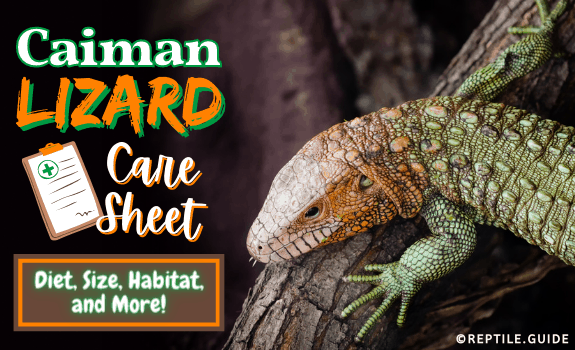The northern caiman lizard is a large, stout lizard native to South America. Their body stature is similar to their close cousin, the famous Argentine black and white tegu.
Caiman lizards are farmed for their hides. Farm-raised caiman lizards have only recently become popular in the pet trade.
Due to the lack of history in captivity, there’s very little information available regarding their husbandry and breeding requirements.
In This Article
Do Caiman Lizards Make Good Pets?
Caiman lizards do NOT make good pets for the average reptile owner.
They’re strong and flighty. One wrong move in a caiman lizard’s presence could land you in a hospital.
You’ll need to dedicate a considerable area in your home – or yard – to house an adult caiman lizard. You’ll also need some carpentry skills or a contractor to build the custom enclosure.
Caiman lizards can’t live in an aquarium from the pet store!
Despite all of the drawbacks, these giants make beautiful and rewarding pets for dedicated owners. They’re among the most intelligent reptiles, right next to their monitor lizard cousins.
It’s vital to research and consider the implications of owning a giant lizard for the next ten or more years before you bring one home.
Caiman Lizard Bites
Caiman lizards have powerful jaws. Their teeth are also sharp. In the wild, they use their strength and weaponry to crush five-inch mollusk shells.
When a caiman lizard bites, it often turns its body repeatedly to rip flesh. This move is known as the “death roll,”; a typical behavior in caiman lizards and crocodilians.
A bite from an adult caiman lizard will almost certainly require stitches. They may be capable of tearing off entire fingers.
Mutual respect and an understanding of lizard body language is a must for caiman lizard ownership.
Facts at a Glance
|
Common Name |
Caiman Lizard |
|
Scientific Name |
Dracaena guianensis |
|
Adult Size |
2 to 5 feet |
|
Native Range |
Northern South America |
|
Lifespan |
10+ Years |
|
Natural Diet |
Primarily snails, supplemented by fish, amphibians, crabs, crawfish, clams, and invertebrates |
|
Natural Habitat |
Swampy, flooded wooded areas |
|
Do They Make Good Pets? |
No (only for experts) |
|
Minimum Enclosure Dimensions |
8’ x 3’ x 4’ (L x W x H) |
|
Temperature |
75-130℉ |
|
Humidity |
60-80% |
Size and Appearance
Caiman lizards have heavy-set bodies with short limbs. They have long, powerful tails and sharp claws. Their heads are blocky with strong jaws.
There are several rows of horned, raised scales running down their back . They look like the scutes along a caiman’s back, hence the name: “caiman lizard.”
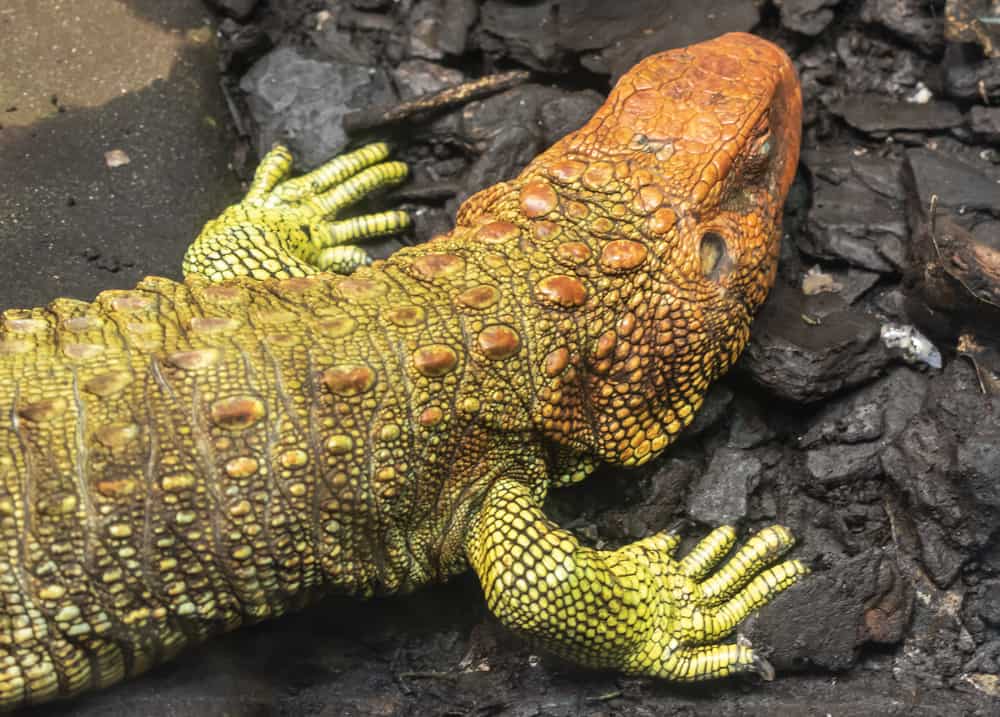
Caiman lizards range from green to brown. Their head tends to be red or orange. Older animals, females, and individuals that are preparing to shed have duller coloration.
Temperament and Behavior
Caiman lizards spend most of their time in or near water. In the wild, their primary diet is apple snails. They’ll also eat fish, amphibians, invertebrates, and other mollusks.
These lizards are easily spooked. While their first inclination is to flee, cornered caiman lizards aren’t afraid of using their teeth, claws, and tails in self-defense.
Lifespan
Average Lifespan: 10+ Years
Where to Buy a Caiman Lizard
Most caiman lizards on the captive market are farm-raised and imported from South America.
In most ways, these lizards are similar to wild-caught animals. They experience the same stress levels, parasite loads, and environmental exposures.
Luckily, purchasing a farm-raised caiman lizard has no impact on their wild populations.
Unfortunately, captive-bred clutches of caiman lizards are few and far between.
Caiman Lizard Husbandry
There’s limited information available about the captive husbandry of caiman lizards. Background knowledge and experience with other lizards are highly beneficial.
Supply List
- Heat lamp
- UVB lamp
- Large branches
- Large hide boxes
- Custom-built enclosure
- Automatic mister or fogger
- A steady supply of snails, insects, and whole prey
- Stock tank, pre-formed pond, or another large water vessel
Caiman Lizard Enclosure Size and Style
Minimum Enclosure Size: 8’ x 3’ x 4’ (L x W x H)
Your caiman lizard’s enclosure should feature a dry land area, a water area, and plenty of climbing opportunities.
If you need inspiration, this DIY iguana enclosure is a great place to start.
Many keepers use modified large turtle tubs. They’re built to accommodate an aquatic zone and a terrestrial zone.
For a caiman lizard, you’d need to craft a topper from wire mesh.
The wire mesh topper should attach securely to the turtle enclosure or tub, which serves as the base for holding substrate and water.
Your caiman lizard needs at least four feet of cage height, equipped with thick branches for climbing.
One thing is for sure: you’ll need a lot of carpentry know-how or a contractor to construct your caiman lizard’s custom, giant enclosure!
Lighting
Ideal Light Cycle: 12 Hours Light/12 Hours Day
UVB: Recommended
It’s best to combine fluorescent UVB lighting and incandescent UVA lighting in one zone. This area will become your lizard’s basking spot.
Many keepers opt to suspend their light fixtures from the roof of the habitat. Eliminate any climbing opportunities that may allow the lizard to come into contact with the heat lamp.
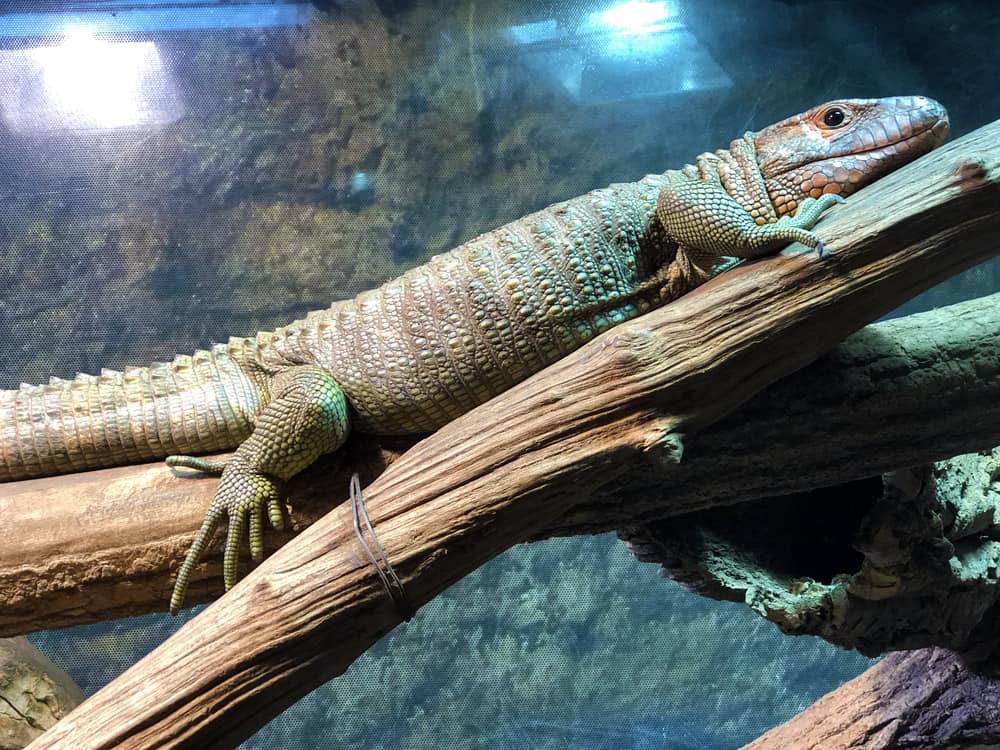
Always remember to turn the lights off at night. Caiman lizards need at least eight hours of darkness to rest and sleep.
Heating
Ideal Basking Temperature: 120-130
Ideal Warm Side Temperature: 85-90
Ideal Cool Side Temperature: 80-85
Ideal Night Time Temperature: 75-80
During the day, the lighting fixtures described above should provide sufficient heat.
At night, you’ll need to come up with a heat source that doesn’t emit light. The temperature needs to remain above 75 at all times. Popular options include:
- Ceramic heat emitters
- Radiant heating panel
- Carbon filament deep heat projector
Always run heating elements on a thermostat to reduce the risk of burns and fires.
Water and Humidity
Ideal Humidity: 60-80%
Moisture-retaining substrates (listed below) will help you maintain humidity levels over 60%. You’ll likely need to invest in an automatic misting or fogging system, as well.
Caiman lizards are semi-aquatic. Their enclosure should include a body of water that’s at least 12 inches deep. It should cover at least one-third and up to one-half of the cage’s floor space.
Avoid the temptation to use a glass aquarium. Caiman lizards can easily shatter the tank with their powerful tail whip. Stock tanks and pre-formed ponds are great options.
A high-powered pond filter or canister filter will help you keep the water cleaner. You’ll still need to change the water out at least two to three times a week.
Without a filter, you need to change the water every day.
Caiman lizards are prone to developing infections from fouled water. They’re messy eaters, and they produce a lot of waste. Fresh, clean water is a must.
Decor and Environmental Enrichment
- PVC pipes
- At least one shelter or hide box
- Deep water for diving (see above)
- Numerous sturdy branches for climbing
- Deep substrate for burrowing (see below)
Decorating a caiman lizard’s enclosure is difficult because of its large size and destructive nature. They destroy live plants, and commercial reptile decorations are too small.
Use photos of others’ tegu enclosures, monitor enclosures, and iguana enclosures for inspiration.
Substrate
Best:
- Sand
- Organic soil
- Coconut fiber
- Coconut husk
- Cypress mulch
Worst:
- Newspaper
- Paper towel
- Reptile carpet
- Pine or cedar
- Aspen shavings
You want the substrate to hold moisture without molding. Your caiman lizard should be able to dig and burrow, too.
Spot-clean the substrate at least once a week. Change the substrate entirely every one to six months.
Cohabitation
Wild caiman lizards are solitary creatures. There are no benefits to housing these lizards in groups.
Their large size and sharp teeth present formidable risks to cage-mates, should a dispute occur. It would be difficult, if not impossible, for any human to break up a caiman lizard fight.
Finally, the size of enclosure you’d need to house multiple caiman lizards would be monumental. We’re entering the territory of bedroom conversions and giant outdoor cages.
As you likely see, the potential drawbacks of cohabitating caiman lizards outweigh the non-existent benefits. Instead, focus on providing the best possible care for your single caiman lizard.
Caiman Lizard Diet and Feeding
Food Options
- Fish
- Fruit
- Eggs
- Clams
- Shrimp
- Crawfish
- Rodents
- Cat food
- Frozen snails
- Live aquatic snails
- Commercial crocodilian diet
- Ground meat with calcium supplements
- Canned snails and other canned insects
It’s best to focus on non-processed, fresh foods. Try to mimic the caiman lizard’s natural diet: snails, fish, insects, and other shellfish.
Amount
Feed your caiman lizard as much as it can eat in 20 minutes or until it’s full.
If you notice that your caiman lizard is packing on the pounds, cut back on feeding frequency and amount.
Frequency
Juveniles (up to one year old): One meal per day
Adults: Every other day
Your caiman lizard’s staple diet should consist of whole prey or low-fat protein with a balanced calcium-to-phosphorus ratio.
Offer fruit, or other plant matter, twice a week.
Techniques
Many caiman lizard owners opt to feed their lizard in a simple pet food dish. Stainless steel bowls are durable and easy to sanitize.
Tong-feeding is an excellent option for getting more hands-on with your pet. Your caiman lizard may learn to trust and even enjoy your presence when you offer meals directly from tongs.
Try to find or breed captive-bred, parasite-free apple snails.
Caiman lizards are intelligent lizards that need mental enrichment. They’ll engage in their natural foraging and hunting behaviors if you add live snails to their water feature.
Supplements
Add a reptile multivitamin to your caiman lizard’s food once a week.
Dust your caiman lizard’s food with a reptile calcium supplement twice a week.
If your caiman lizard has consistent access to UVB exposure, ensure that the calcium does not contain added vitamin D3. Vitamin D overdose and toxicity are possible.
If your caiman lizard doesn’t have access to a UVB lamp or sunlight, ensure that the calcium does contain added vitamin D3. Otherwise, your lizard will be at risk for MBD (metabolic bone disease).
Regurgitation
Regurgitation is similar to vomiting. Usually, regurgitated food is more recognizable because it’s less digested.
Reptiles regurgitate their food for many reasons:
- Stress
- Disease
- Parasites
- Dehydration
- Low temperature
Ensure that the temperatures and humidity in the habitat are ideal. Encourage water intake by offering fresh water more often and misting the enclosure.
After your lizard regurgitates, allow it to fast for 24 hours before offering food again. Avoid handling your lizard while it fasts and for 24 hours after its next meal.
Regurgitation is a relatively common one-time occurrence, especially for animals adjusting to captivity or a new enclosure.
If it occurs repeatedly, and the above measures don’t rectify the situation, take your caiman lizard to a veterinarian for an examination and diagnostic testing.
Anorexia
Caiman lizards usually have voracious appetites. If your caiman lizard isn’t eating, something is wrong.
If you’ve recently acquired your caiman lizard, give it a few days to adjust. Stressed animals avoid eating. Don’t handle them and avoid going near their enclosure.
Be sure to offer the same food that the previous owner was feeding it.
If your caiman lizard is wild-caught, try to find apple snails. That’s what they eat in the wild.
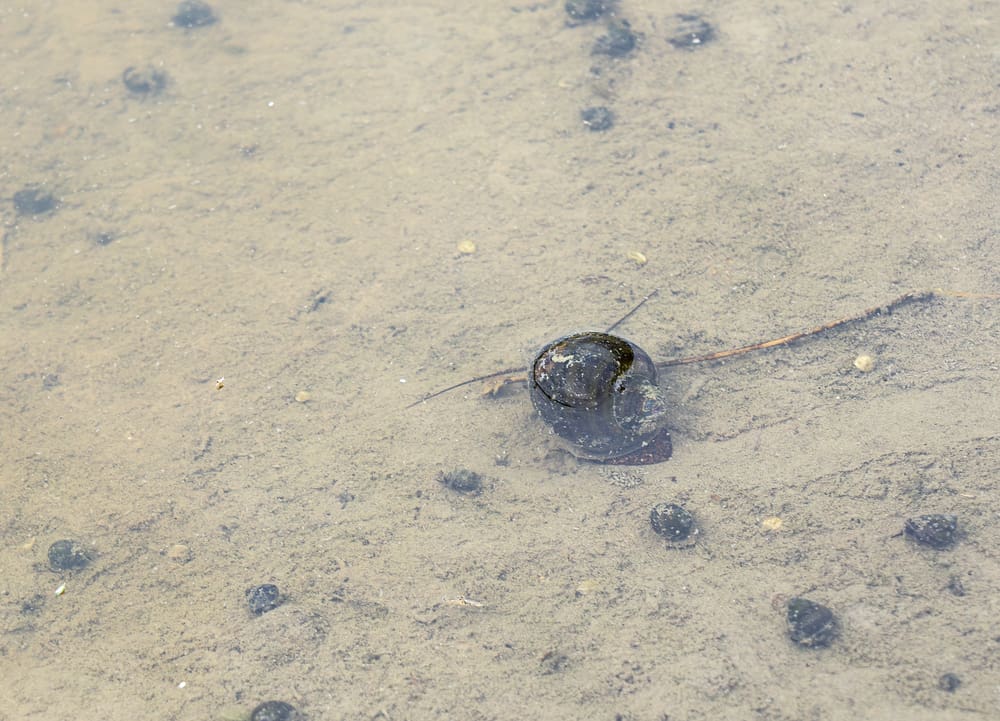
After 48 to 72 hours, make an appointment with your lizard’s veterinarian for an examination and diagnostic testing.
Breeding Caiman Lizards
Few private caiman lizard keepers have had luck with breeding this species in captivity. Most instances seem to have occurred spontaneously.
Caiman lizards reach sexual maturity at around four years of age.
Determining the Sex
You can easily sex a caiman lizard by the time it reaches three years old.
Males are much larger, sometimes reaching up to five feet long. Their head is blocky and bright red.
Females reach a maximum size of four feet. Their heads are smaller and less bright.
Mating
Given their close relation and similar natural habitat to tegu lizards, breeding requirements for caiman lizards are likely similar.
Egg clutches seem to have increased fertility when there are multiple males in the breeding group.
Egg Incubation
Wild caiman lizards lay five to seven eggs in burrows on riverbanks. The incubation period is roughly 185 days.
Mothers guard their nests, but no information suggests they care for the hatchlings.
There’s no public information regarding the ideal incubation temperature for caiman lizard eggs. Again, we fall back on tegu guidelines: 86-90°F is a good starting point.
Hatchling Care
Hatchling caiman lizards have the same care requirements as their adult counterparts.
Consider keeping the humidity at the higher range of normal for the first few weeks. It’s a shock to the system to go from being submerged in an egg to the dry air of the world!
It may be more sensible to feed insects than rodents and other large prey. Be sure to increase calcium supplementation accordingly.
Snails should still make up the bulk of a hatchling caiman lizard’s diet.
Caiman Lizard Health and Wellness
The keys to your caiman lizard’s health and longevity are:
- Mental enrichment.
- Veterinary care, as needed.
- A clean, sanitary environment.
- A healthy, fresh, varied diet that closely replicates their natural diet.
- Appropriate temperature, humidity, UV exposure, and habitat set-up.
Signs of a Sick Caiman Lizard
- Inactivity
- Weight loss
- Not basking
- Open cuts or wounds
- Open-mouth breathing
- Lack or loss of appetite
- Mucous discharge from mouth or nostrils
Dropped Tail (Autotomy)
Stressed caiman lizards may drop their tail. This ability is known as autotomy.
In captivity, a dropped tail is nothing but an unfortunate event. Caiman lizards are capable of re-growing their tail and making a full recovery.
All that you can do is keep the fresh wound clean and healthy. Head to the veterinarian if conditions worsen. Signs of infection include:
- Foul odor from the wound
- Discharge from the wound
- Green or black discoloration that’s spread
Metabolic Bone Disease (MBD)
MBD is a common issue in captive reptiles. It’s caused by an imbalance in the animal’s calcium to phosphorus ratio.
The first step to preventing MBD is to provide a balanced dietary Ca:P (calcium:phosphorus) ratio of 2:1. Whole prey and calcium supplementation are a great start.
We recommend offering UVB basking lights or using calcium powder that includes added vitamin D3. Your caiman lizard can’t absorb calcium without vitamin D3.
If your caiman lizard has already developed MBD, seek veterinary guidance. You may be able to reverse the symptoms by correcting dietary and husbandry management.
Lethargy
Lethargy is one of the most common symptoms of illness or poor husbandry in caiman lizards.
If your caiman lizard is acting uncharacteristically sluggish, be sure to:
- Bump the humidity up to at least 75%
- Offer UVA (incandescent) and UVB (fluorescent) lighting
- Ensure the basking spot reaches a temperature of at least 120
- Encourage your caiman lizard to eat a healthy diet with appropriate supplementation
After improving any sub-par conditions, give your caiman lizard 24 to 48 hours to perk back up. If things don’t start looking better, make an appointment with your veterinarian.
Wounds
Wounds are a fact of life for these giant, powerful, and occasionally skittish lizards.
The best course of action is to keep the wound clean. This entails meticulously cleaning waste from the enclosure and changing the water often – perhaps several times a day.
If the wound starts to look infected or your caiman lizard begins to show other signs of illness, make an appointment with your veterinarian.
Respiratory Infection
Respiratory infections are caused by a weakened immune system, improper temperatures, and improper humidity levels.
Symptoms of a respiratory infection include:
- Drooling
- Swollen face
- Noisy breathing
If you notice any of these symptoms in your caiman lizard, make an appointment with your veterinarian immediately. Respiratory infections require antibiotic treatment.
Eye Infection
Eye infections are caused by dirty, stagnant water. Be sure to change your caiman lizard’s water at least once a day, and scrub the container at least once a week.
Symptoms include:
- Red eyes
- Keeping one or both eyes closed
- Scratching or clawing at eyes or face
Like all infections, eye infections are treated with antibiotics prescribed by your veterinarian. Make an appointment immediately if you suspect your caiman lizard has an eye infection.
Ear Infection
Due to their aquatic nature, ear infections are common in caiman lizards. The primary symptom is a bulge behind or under the lizard’s ear.
Make an appointment with your veterinarian so they can drain the infection and prescribe the appropriate antibiotic.
External Parasites
External parasites, like mites, are highly uncommon on caiman lizards. Their thick scales and aquatic lifestyle have left them resistant to external pests.
If you do notice any tiny invaders on your caiman lizard’s skin, it’s safe to use a commercial reptile mite spray. Follow the instructions on the packaging.
Internal Parasites
Most farm-raised caiman lizards have a manageable load of intestinal parasites. The stress of importation weakens the lizard’s immune system, allowing the population of internal parasites to explode.
Intestinal worms will steal nutrients from your lizard and stunt its growth. They may even cause your lizard to become impacted or lose its appetite.
We recommend that you make an appointment with your veterinarian to determine the correct drug and correct dose for treating your pet’s worms.
Signs of a Healthy Caiman Lizard
- Plump tail
- Rounded abdomen
- Hip bones not visible
- Animal is active and alert
- Nostrils clear with no crust or discharge
- Eyes are clear of discharge and open with no squinting
Veterinary Care
It’s challenging to find a veterinarian that’s willing to and has experience with treating exotic pets.
Luckily, the Association of Reptile and Amphibian Veterinarians has a “Find a Vet” tool. We advise you to find a reptile-friendly veterinarian before you need one.
Growth Rate
The growth rate seems to vary dramatically between individual caiman lizards. Lizards may grow slower due to:
- Improper diet
- Excessive stress
- Heavy parasite load
- Poor supplementation
- Regenerating a dropped tail
- Inadequate exercise opportunities
In general, most caiman lizards reach their full size by their third birthday. Two-year-old caiman lizards are usually already past three feet.
Shedding
You can expect your juvenile caiman lizard to shed every two to six weeks.
If it’s not shedding that often, it may not be growing at a healthy rate. Double-check your husbandry and have your veterinarian’s office examine your lizard’s stool for parasites.
Unlike most other lizards, caiman lizards are prone to having stuck-on pieces of shed skin. Avoid this issue by increasing the humidity and offering a large water feature.
Stuck sheds can build up and cause tissue necrosis, especially around the toes and the tail tip. If the lizard’s natural soaking behavior doesn’t loosen the skin, rub vegetable oil on it.
Caiman Lizard Handling and Bonding Tips
It’s essential to exercise a healthy degree of caution when interacting with your caiman lizard. These guys are capable of inflicting a nasty bite, and they’re easily spooked.
The most critical aspect of caiman lizard bonding is building trust.
Your lizard must trust you in order to not react and bite or tail-whip you.
In turn, you must trust your lizard so that you can handle it confidently and avoid mistakes.
Frequency
Give your caiman lizard 7-14 days to adjust to its new surroundings before interacting with it.
Once it seems reasonably comfortable in its environment and it’s regularly eating, your work begins.
Handle your caiman lizard at least two to three times a week to maintain tameness and trust.
Techniques
Start by approaching the enclosure without opening it. Do this two to three times a day or more. Once your caiman lizard stops reacting to your approach, you may continue.
The next step is to open the enclosure and rest your hand inside. If they start hissing, huffing, or arching, move your hand further away from them.
Gradually, over days or even weeks, you will begin to move your hand closer.
Move at your lizard’s pace. Don’t move any closer unless your caiman lizard appears relaxed.
Eventually, you will be close enough to touch your caiman lizard. Limit petting to five minutes at a time, then ten minutes at a time.
Once the caiman lizard is comfortable being touched for at least ten minutes, you can try to pick it up. Again, start by holding it for five minutes at a time, then ten minutes at a time.
Limit the time that you’re gripping or restraining the lizard. They prefer to be able to move freely on your hand or arm.
It’s normal for a young caiman lizard to panic for a moment when you pick it up. If it doesn’t calm down as soon as you release it on your arm, go back to the last step of touching only.
From here, it’s a matter of gradually increasing the duration of handling – perhaps adding five minutes every other day, as your caiman lizard tolerates.
The final word of advice: wear a thick, long-sleeved jacket or sweater. Caiman lizards use their sharp, thick claws to grip when they climb.
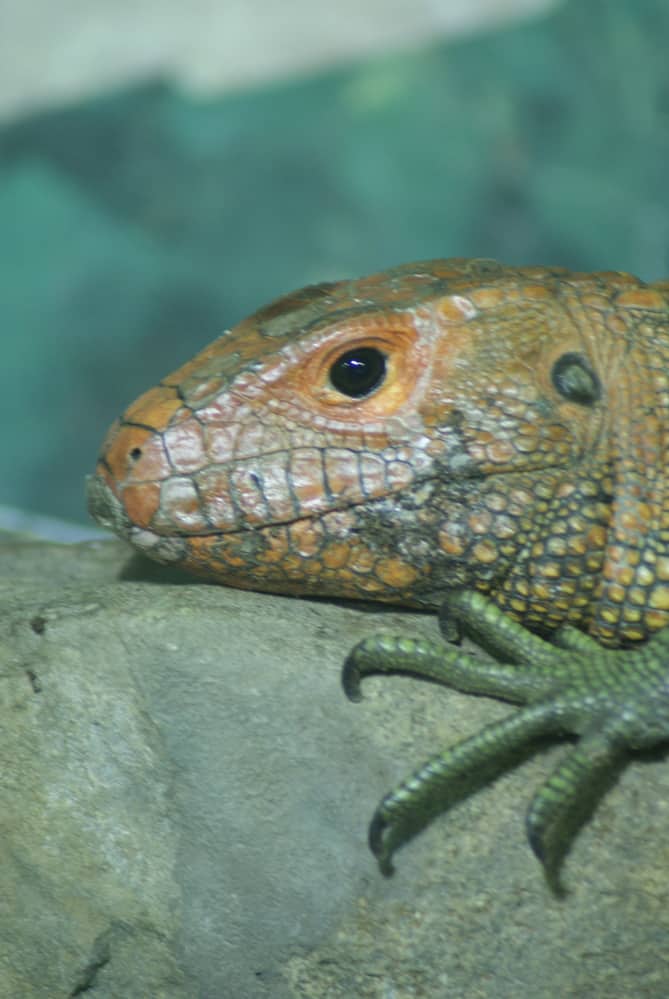
More Lovely Lizards
As beautiful and intelligent as they are, their sheer power and the limited available information make caiman lizards difficult for even experienced reptile hobbyists.
Truthfully, we recommend that any prospective caiman lizard owner gets several years of experience with smaller, easier lizards before taking on the challenge of this rare beauty.
Giant, uncommon reptiles require specialized supplies and techniques. It’s hard to imagine what caring for an adult entails when you’re looking at a cute baby in the pet store!
What kind of large, obscure reptiles have you been tempted to bring home? Tell us about it in the comments below!
